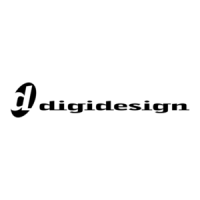Chapter 22: Events 207
Using the Templates
To add any of the Events listed in the table, do the following
(using the first template, Talkback (Toggle) as an example):
To use the templates:
1 Create a new event.
2 Edit the event name (for example, “Talkback (Toggle)” as
shown in the table). For renaming instructions, see “Renam-
ing an Event” on page 200.
3 Click the (Trigger) Add pop-up menu and choose Footswitch
> Switch 1 (Footswitch 1). The Switch 1 trigger type is added,
with a default State setting of Closed.
4 Click the (Action) Add pop-up menu and choose Talkback.
The Talkback action is added. By default, the action State is
Toggle, and the behavior is Latched. There is no Wait (delay be-
fore firing) needed for this action.
Switch 1 (Footswitch 1) is now configured to toggle Talkback
On or Off each time the footswitch is pressed.
If you prefer momentary talkback, edit the event by doing the
following.
1 Double-click the Talkback action in the Actions list to access
its editable properties. Or, right-click the action and choose
Edit.
2 Click the action State pop-up menu (it displays Toggle by de-
fault, or the current State setting) and select On.
3 Click the action Behavior pop-up menu and select While Ac-
tive. Together with the State setting (On), While Active estab-
lishes momentary control of the action; in this example,
Footswitch 1 is now assigned to provide momentary Talkback
control.
4 To quickly test the switch trigger, click the Test button, or
press the Footswitch. Adjust the trigger State for your foot-
switch, as necessary, for its open/closed orientation. (For in-
structions, see “Editing Trigger Type and Properties” on
page 202.)
5 After testing the trigger, click Reset to return the event to its
Ready state.
Tap Tempo for Plug-ins
Tap Tempo lets you quickly establish a system tempo to use as
a beat clock for delay and echo plug-ins that support Tempo
Sync.
The system tempo defaults to 120 BPM (beats per minute).
You can set a custom tempo in a number of ways including by
tapping a Function switch, Footswitch or other control as ex-
plained below. The system tempo is stored as a console setting
within the Show file.
Snapshots can also store and recall tempo.
Using Tap Tempo
Do the following three steps to start using Tap Tempo:
Enable the System Tempo
1 Go to the Options > Misc page, locate the Tap Tempo section
and do the following:
• Turn on the global tempo sync by clicking the On switch
directly below the encoder so that it is lit (on).
• If desired, use the encoder to set a system tempo value, or
type a value directly into the Tempo field.
• If desired, click the Units selector to choose Beats Per Min-
ute (BPM) or Milliseconds as the units for displayed values.
An action and its properties ready to be edited.
Talkback State and Behavior after editing
Action Type BehaviorState
A preconfigured Event for tap tempo is installed in the
Demo Shows folder when you install VENUE D-Show soft-
ware. To use the example Event, go to the Filing page and
click the Load tab, then select the file Tap Tempo Examples
and click the Load button.
Tap Tempo settings

